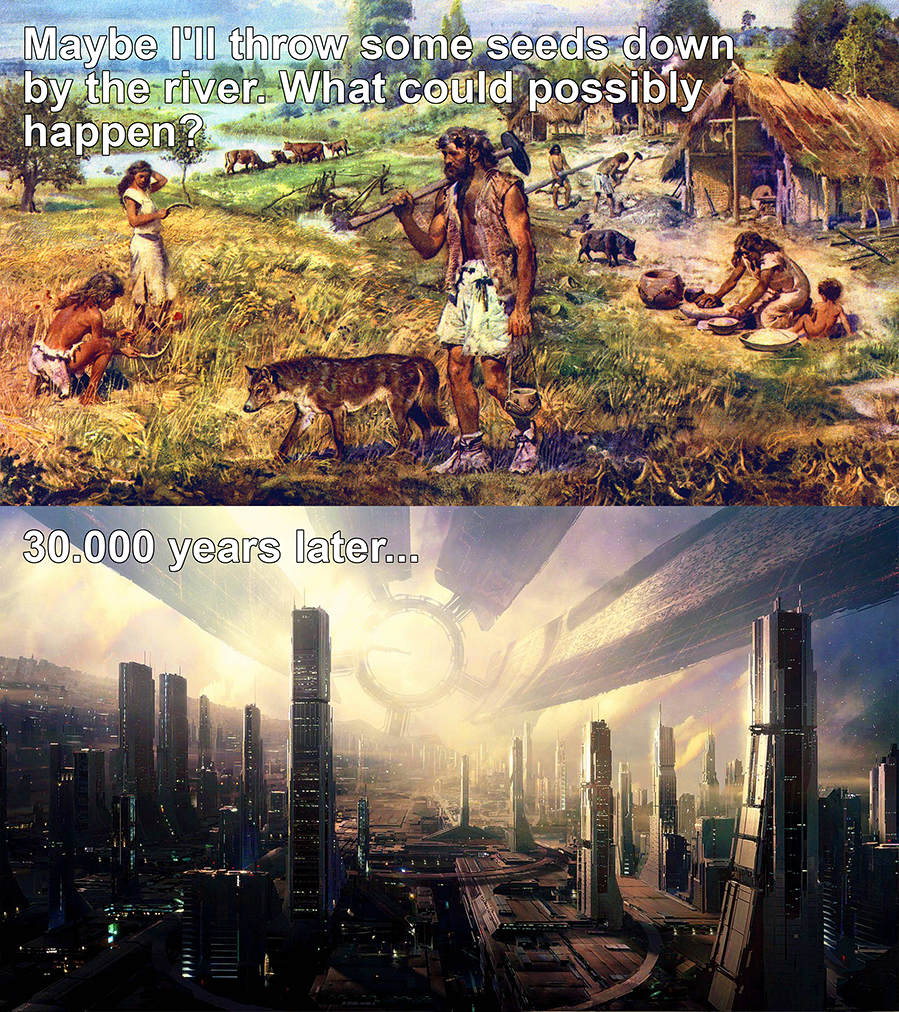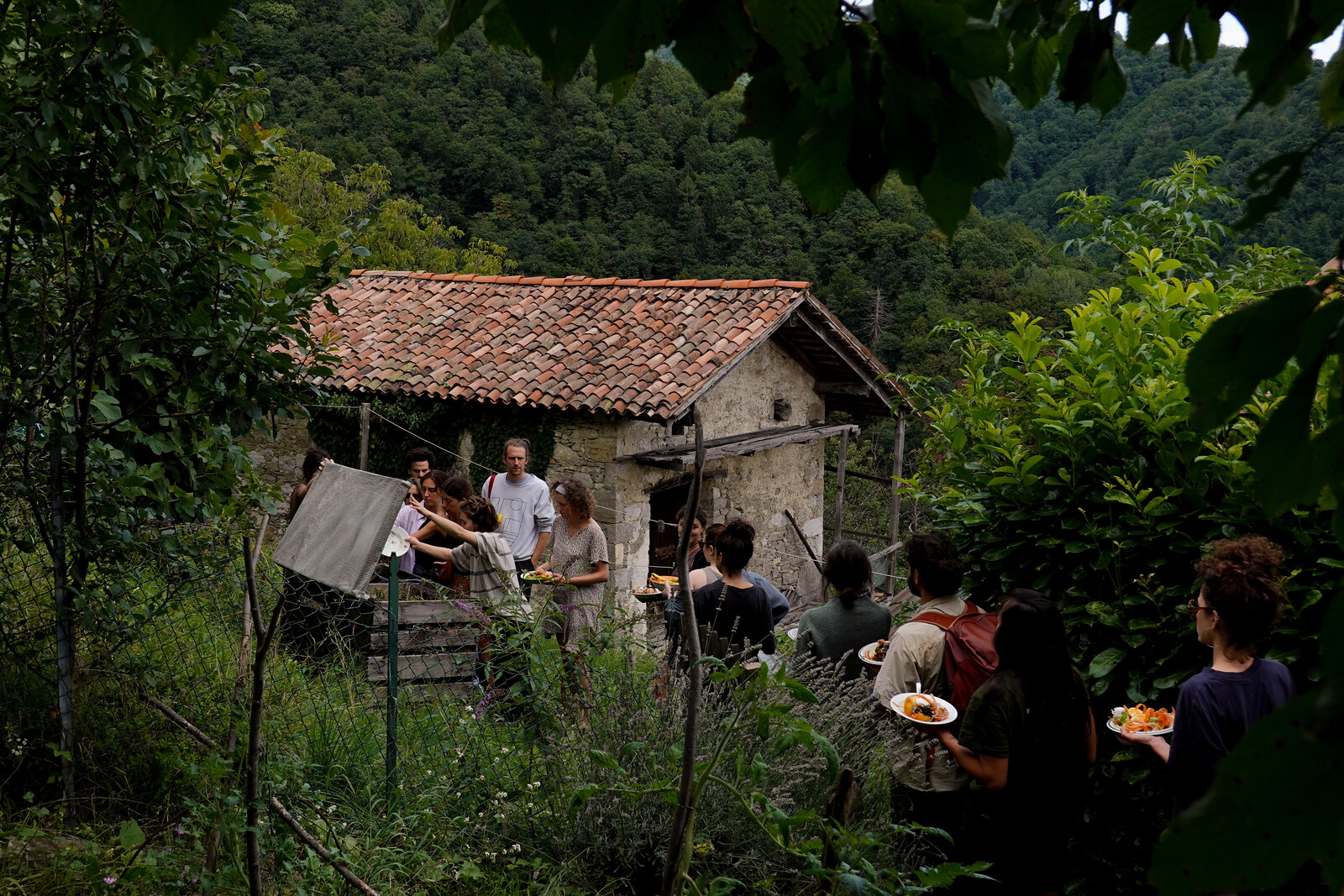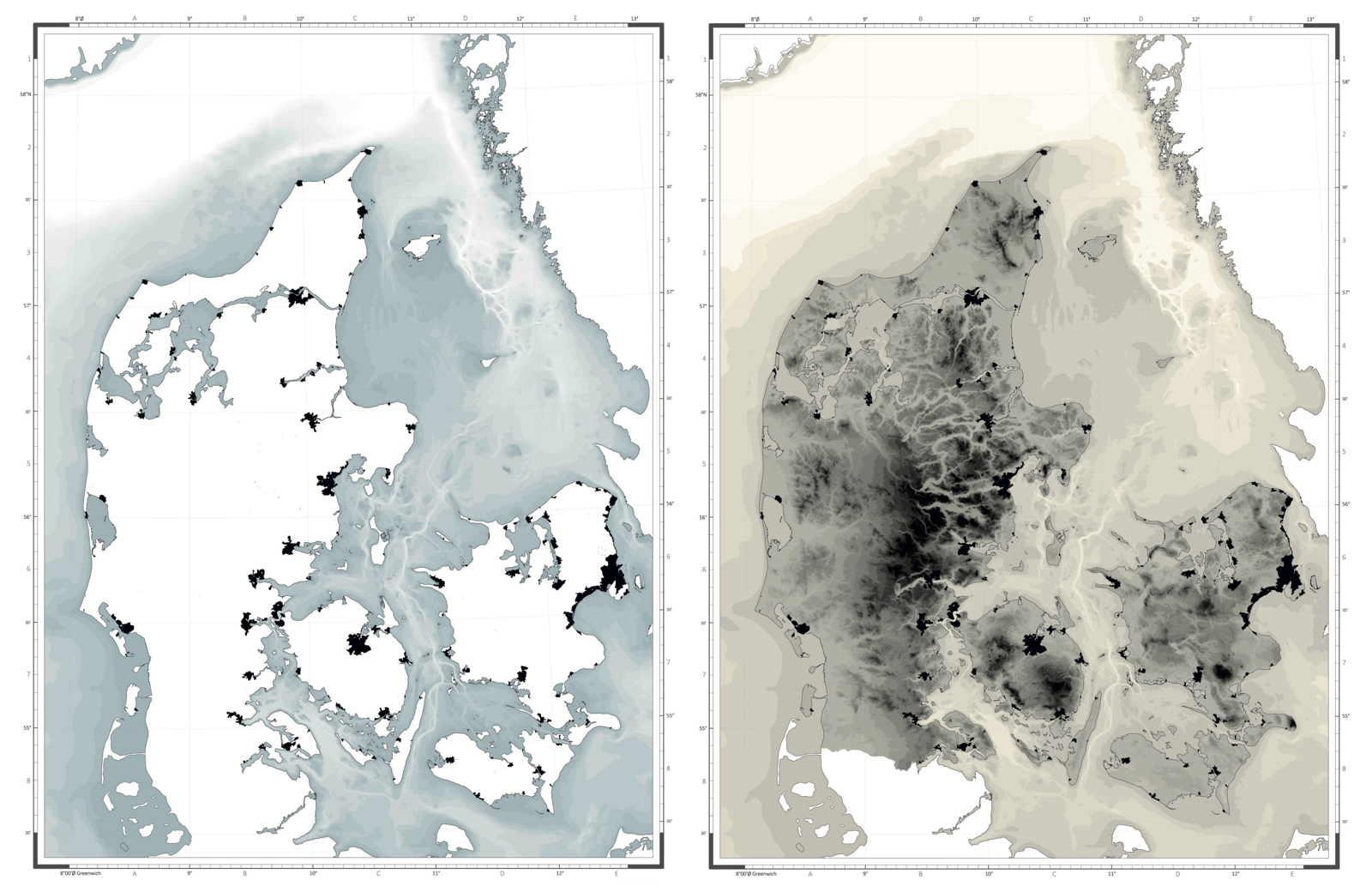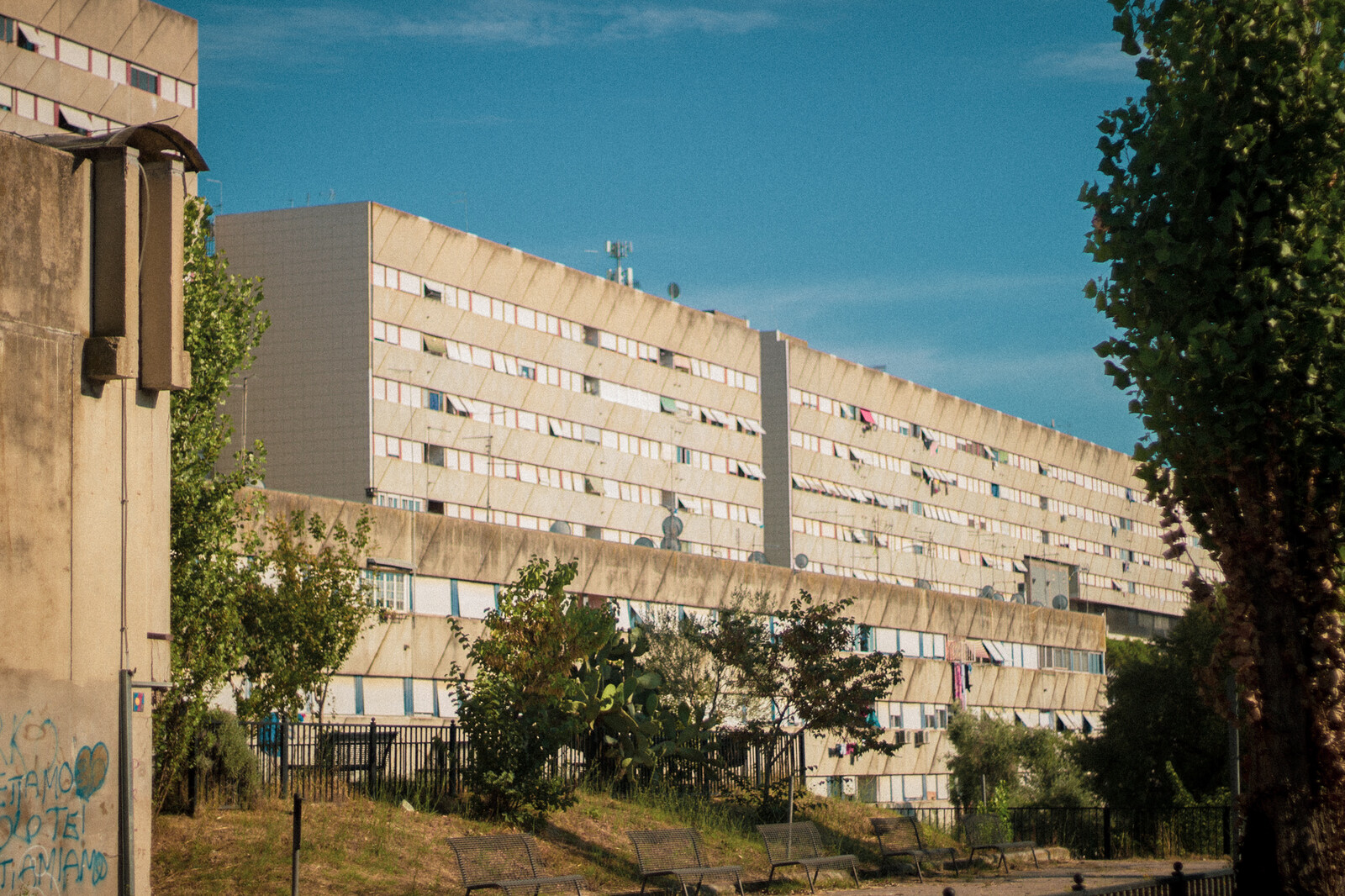Think about your last meal. Visualize its ingredients, colors, and flavors. Now, try to think about how it ended up on your plate; what sort of spaces it passed through, what kinds of architecture and infrastructure were involved in such a journey. Let’s begin at the everyday laboratory that is your kitchen, where your meal has likely been assembled from tiny cans, containers, and packages. Moving backwards, these ingredients likely came from the supermarket, where they were located on meticulously ordered shelves, strategically placed to trigger consumptive desire. They were brought there by nomadic autonauts who navigated and safeguarded them along roads and motorways connecting cargo ports, logistics centers, and human exclusion zones. Further in the past, there are the plantations, greenhouses, and slaughterhouses where much of our food is grown. But in the beginning, it was photosynthesis, nitrogen fixation, and microbial metabolism that fossilized the sun into an infinite variety of textures and flavors; it was the soil, through which the geological becomes biological.1
By eating, we digest territories. Initiated some 12,000 years ago, the food system is the first, and perhaps most successful, geoengineering project ever undertaken by our species.2 From the moment humans learned to harvest the power of the sun, agriculture and architecture have evolved in parallel, radically transforming our landscapes and cultures. Industrial society alienated the act of eating from the systems, landscapes, technologies, and bodies that must be exploited for it to happen. Even so, food mobilizes our societies, shapes our metropolises, and transforms our geographies more radically than any other human energy source.
As much as food shapes our cities, architecture shapes the ways we produce, distribute, and consume it. Every time we eat, we connect our palate to a plethora of remote sites, from supermarkets, greenhouses, and farms to warehouses, logistical networks, cold chains, and wastelands. Despite their immense importance, these anodyne architectures rarely receive the attention they deserve. Beyond their individual roles in our food chains, together they form a vastly distributed apparatus that reassembles the earth’s crust into the building blocks of human life. This multi-scalar, multifaceted, metabolic architecture allows humans and animals alike to sustain the integrity of our corporeal composition.3
In a world where the molecular is tectonic and every bite reverberates across the planet, we are urged to rethink the ecosystemic implications of our food systems. The architectural question of the agri-food system is not so much about its internal structure, but rather, how can we re-imagine and renew the constitutive layers of these systems? Can they be redesigned or repurposed to feed the world without depleting the planet?
Foundation: We Are Digested Soil
As diverse as any rainforest or coral reef, the soil beneath our feet constitutes the foundational layer of the food system. Soil is a complex ecology of microscopic processes and assemblages that mediates the chemical transformation of the geological into the biological, the inorganic into the organic. It is soil we can thank for the richness and diversity of our pantries. However, despite its cultural, infrastructural, and ecosystemic importance, the mechanisms through which soil functions remain largely mysterious and poorly understood. As Grandeza Studio and Locuments state in “Strata Incognita”:
Just a few centimeters beneath your feet, millions of creatures kill and eat one another, fight, reproduce, and forge alliances, implementing the myriad of processes that recompose death into life while purifying the water you drink, making the air you breathe breathable, and growing 95% of the food you eat. We are digested soil.4
Even if they escape from the regime of the visible, the microscopic narratives emerging in this veiled realm are macroscopic in scale and scope.
The exhaustion of our soils and their loss of fertility is one of the main threats to the sustainable future of the food system. Over the past hundred years, soil fertility has been guaranteed thanks to the use of artificial fertilizer. This fertilizer allowed nitrogen fixation, an essential process in growing crops, to exponentially increase, enabling the production of enough food to allow for global demographic growth. It is calculated that half of the nitrogen atoms in our bodies today come from artificial nitrogen fixation.5 But this has all come at the expense of the biochemistry and multispecies relationships that take place in the soil.
Changing these dynamics will necessitate the decommodification of soils. Instead of viewing soil merely as a tool or resource to be exploited, it should be seen as an interdependent ecosystem. This demands new models of multidirectional stewardship and biochemical care, ones that would foster a symbiotic relationship between crops and the soil sustaining them. But instead of romanticizing nature and a lack of human presence, we should recognize that some of the most fertile soils on our planet are anthropogenic. Known as “terra preta,” these dark earths of the Amazon were created by ancient indigenous populations through the addition of biochar, bone, and manure to poor soils. This practice transformed infertile soils into rich, productive lands that continue to remain highly fertile centuries after their original formation.
The creation of terra preta is a prime example of how human intervention, when aligned with ecological principles, can enhance soil fertility sustainably. Ancient techniques such as these are already being revisited and adapted in modern agricultural practices to address contemporary issues of soil degradation. For instance, extensive soil and water conservation efforts in the Loess Plateau in China—including constructing terraces, planting trees, and grassing waterways—have reduced soil erosion, improved water retention, and ultimately restored ecological balance, transforming a once barren landscape into fertile land.6 Similarly, by integrating the use of biochar and other organic materials into contemporary farming practices, soils can be regenerated, carbon can be sequestered, and crop yields can be improved, all while reducing reliance on synthetic fertilizers that contribute to soil exhaustion and environmental pollution.7
Production: Our Diets Require Territorial Construction
Although cities occupy only a tiny fraction of the earth’s crust, the operational landscapes required to sustain them sprawl across vast expanses of land. In Spain, more than 23 million hectares—nearly half of the country’s surface area—are utilized for this purpose. The productive layer of the food system is composed of agricultural landscapes and the architectures that facilitate their functioning. Within these productive geographies, a complex interplay among territorial, human, animal, and mechanical bodies occurs, with each entity contributing to a multifaceted, inter-scalar dance.8 It is against this backdrop that issues such as colonization, deforestation, biodiversity loss, and animal exploitation converge.
Though often out of sight, the structure and functionality of this layer are intrinsically linked to our dietary habits. Preferences for certain dishes or foods over others can have cascading effects on the landscapes instrumentalized for their production. To geoengineer our landscapes, we might therefore start with our own palates. In “Protein Clickbait for the 14%,” Common Accounts delves into the systemic and territorial implications of protein supplements, which in Spain are consumed by 14% of the population, highlighting the connection between anthropoforming our abs and terraforming the landscapes that shape them.9
Despite the allocation of nearly half the land on Planet Earth to agriculture, we limit our diets to a constricted biological palette and a dwindling array of species.10 In the vast library of Earth’s flora and fauna—over 50,000 edible plant species and 8.7 million animal species—our diets are astonishingly monolithic. A mere fifteen plant species constitute 90% of global caloric intake,11 and just three animal species make up 93% of the world’s consumption of meat.12 This homogenization starkly contrasts with the rich biodiversity of our planet, highlighting an urgent need to broaden our culinary and agricultural horizons.
With eight billion mouths that need to be fed, addressing the complexities of production is less about pursuing agrarian nostalgia and more about enhancing diversity in multiple dimensions. This diversity encompasses not only the biodiversity of species available for human consumption, but also a technodiversity of production methods that transcend the traditional dichotomy between natural and artificial systems.13 Moreover, it involves a geodiversity of solutions that leverage the performance of soils and climates to meet nutritional needs in a sustainable manner.
This multifaceted approach requires rethinking agricultural practices, food distribution systems, and consumption habits. For instance, Costa Rica’s adoption of agroforestry practices showcases how integrating trees with crop and livestock production enhances biodiversity, improves resilience, and supports farmer livelihoods. Meanwhile, the Netherlands’ advanced high-tech greenhouses exemplify how precision agriculture and controlled-environment farming can drastically increase efficiency and sustainability in food production, reducing the environmental footprint while maximizing output.
Technodiversity in agricultural production could include precision agriculture techniques, such as using satellite imagery and Internet-of-Things sensors to optimize crop health and yields, thereby reducing waste and the need for chemical inputs. But it could also mean more chemistry and biology, embracing innovative approaches for nutrient creation such as artificially enhanced plants, solar foods, and lab-grown meat, which have the potential to produce food more efficiently and with smaller environmental footprints.
Geodiversity, on the other hand, emphasizes the importance of tailoring agricultural practices to the unique characteristics of different regions—considering factors such as soil type, climate, and water availability—as a way to enhance productivity and resilience against climate change. This could involve the revival of indigenous farming practices that have evolved in harmony with local ecosystems, as well as the adoption of crop varieties that are better adapted to specific conditions.
Ultimately, the aim of incorporating techno- and geodiversity is to create a more resilient, efficient, and equitable food system that can sustain the growing global population while mitigating the causes and the impacts of climate change as well as biodiversity loss. It calls for a collective reimagining of the food production landscape, in which technological innovation and multicultural wisdom converge to domesticate a hyper-diversified set of options both on our daily menus and in the landscapes sustaining them. At the end of the day, nutrition is chemistry—a mix of carbohydrates, proteins, fat, fibers, vitamins, and amino acids. Food, however, implies a cultural dimension that domesticates the chemistry behind it through pleasure, identity, and history. The food regimes of the future require the redesign of culture as much as they require a reconsideration of chemistry.
Distribution: Aesthetic Regimes of Time and Space
Despite earnest attempts to embrace locavore diets, food systems remain deeply entrenched in global paradigms. An intricate logistical network functions as a distributed conveyor belt transporting billions of calories and linking tastes to diverse, distant locations. This includes the automated landscapes of container ports and the precarious labor underlying delivery platforms in the gig economy. The distribution layer of the food system encompasses the relationship between food and its movement, and weaves through various infrastructural, economic, and technological dynamics.
The evolution of distribution over time has been defined by a relentless battle against two physical foes: time and space. On the one hand, the creation of an extensive infrastructural network across the globe has facilitated the rapid spread of goods to the most remote corners, turning the exotic into the mundane and making global culinary diversity more of a casual decision than a marvel of technical ingenuity. This global network would not be possible without huge engineering projects, like the Suez Canal, which have become critical arteries for international trade. However, the vulnerability of these infrastructural giants and the fragility and complexity of our global distribution systems often remains unnoticed until incidents like the Evergreen crash occur.
Food’s battle against space is easier to win than its battle against time. While food preservation is ancient, advances in food pharmacology, such as modern preservatives and the cold chain—which includes climate-controlled warehouses and containers that mimic polar conditions—have only recently allowed the metabolic decay of food to be “frozen.” In places like Mercabarna, a 24-hour food city servicing Barcelona, for example, artificially controlled atmospheric rooms have reduced oxygen levels to prevent molecular deterioration, ensuring that fruits and vegetables from the sunny coasts of southern Spain reach northern Europe in edible condition.14
The carbon footprint of food’s globetrotting and the precarious conditions of those ensuring its delivery demand urgent calls for reformation. Rather than adopting a de facto localist approach, however, the challenge lies in designing food’s distribution with a greater understanding of its energy implications per calorie/mile transported. In the United States, local food hubs in Vermont, such as the Intervale Center, demonstrate the potential to reduce food miles and support small farmers by connecting them directly to local consumers. Meanwhile, Sweden’s Zerologistics project shows how innovative distribution models, such as its carbon-neutral logistics, can use electric vehicles and smart routes to minimize the environmental impact of food transport on a global scale.
However, the most sophisticated element of distribution is neither mechanical nor chemical, but optical: a visual infrastructure that creates aesthetically appealing images of food. Often, the images on labels, delivery apps, or television ads display succulent foods made of plastic or showcased in sensually lit scenes, where color, gloss, and freshness are enhanced to ignite our consumptive desires.15 It is ultimately this visual infrastructure, these aesthetic regimes that imprint food with motion, that are responsible for sparking the irresistible urges that drive food to our tables. Alongside fostering a collective awareness and adaptation towards more sustainable practices and technologies, we might also reshape aesthetics to intervene in the operational images that trigger movement.


Kitchen of the restaurant Las Margaritas Casa de Comidas in Madrid. Photo: Pedro Pegenaute, 2023.
Consumption: Our Kitchens Are Battlefields
Far more than a space for cooking and preparing meals, kitchens are sites of profound cultural and political significance; they are where our social realities are constructed.16 Kitchens have always been technical extensions of our stomachs. It could even be argued that digestions does not start in the mouth, but in the fires and on the cutting boards of these domestic laboratories. From prehistoric bonfires to molecular gastronomy, kitchens materialize our essential needs. Their architectures, spaces, and technologies are the product of histories, culture, language, identity, and senses of belonging.
At the core of the consumption layer of the food system is the power of kitchens as sites for political and social transformation. The redefinition of the kitchen can challenge established norms and hierarchies, creating more just and equitable social and ecological structures in the process. Current domestic kitchen models, while having undergone significant evolution over recent decades, still fundamentally respond to a family structure reminiscent of the nuclear family idealized by Western societies. These models have been artificially constructed and standardized, especially following World War II, through the rise of consumerism and the notion of the separate, appliance-laden kitchen as a domestic ideal. Historically, however, diverse kitchen models have existed, such as communal kitchens in the Soviet Union, which were designed to liberate women from domestic labor and foster a collective ethos. In many non-Western cultures, kitchens have traditionally been more integrated with communal living spaces, supporting extended family structures and fluid social interactions.
Prevalent kitchen models instrumentalize different kinds of bodies and operate both within and beyond domestic environments. They are sites of collective as well as often invisible labor. For instance, ghost kitchens have revolutionized food delivery, operating multiple culinary businesses within a single space, and taking over entire urban neighborhoods.17 Decoupling food preparation from consumption is not a new phenomenon, as was seen with the advent of ready-made meals and fast food. However, ghost kitchens refine and extend this separation to a new level. They operate by centralizing culinary production in hidden locations exclusively for delivery, effectively transforming urban neighborhoods without a direct consumer interface. This model capitalizes on the efficiencies of digital platforms and different urban mobility methods, connecting supply with demand through armies of human automata.18 In contrast, communal kitchens in Mexico and traditional Txokos in the Basque Country serve as vital community hubs, where collective cooking and eating practices strengthen social bonds and preserve cultural heritage. These spaces challenge the conventional restaurant model and promote a more sustainable and community-oriented approach to food consumption.
The advent of new personalization technologies also enables mass-produced food to be modified at home. Beyond futuristic approaches like food digitalization, which promises to create databases of recipes that can be 3D printed,19 more grounded alternatives are gaining traction such as time-saving replacement products or startups that provide customized home-delivery meals tailored to individual dietary requirements. Promoted by trendy influencers, these companies are quickly becoming a staple for Gen-Z and young millennials, who value personalized and convenient meal solutions.20 In rethinking the domestic laboratory that is the kitchen, the benefits of technological advancements should be balanced with their social ramifications, ensuring that the march towards personalization and efficiency does not compromise collective well-being.
Digestion: New Food for New Stomachs
When we eat, we are not the only ones involved in the process of digestion. The UN estimates that around 17% of all food produced ends up in the trash.21 Alongside the by-products of our own digestive processes, our leftovers begin an invisible journey, winding their way through the bowels of our cities. It is in these unseen places that the contracts between urban spaces and the ecologies that sustain them are negotiated and signed. The digestion layer is composed of the intricate, often hidden, infrastructures that manage and metabolize our food when we discard it as waste, and reveals the complex entanglements of the urban and ecological systems underpinning our daily lives.
Historically, in the Western world, waste has been conceptualized as the useless matter that arises from the decomposition or destruction of a resource. It is a cultural byproduct of the alleged inability for things to hold value. Consequently, waste management infrastructures have often been designed more to remove waste from sight than to reintegrate it into the metabolic flows of energy and matter. This has created certain types of landscapes produced accidentally by accumulation—from city-sized artificial mountains on the outskirts of cities to wandering plastic islands adrift in the North Pacific Ocean.22 Such phenomena illustrate the endpoint of a linear waste management model.
The future of waste management in urban environments requires a shift from linear disposal methods to circular strategies that valorize waste as a resource.23 These strategies include the development of urban composting facilities that turn organic waste into soil nourishment. Waste-to-energy technologies can transform non-recyclable waste into electricity and heat, fulfilling energy needs in a sustainable manner. Upcycling waste into new food products for both human and non-human consumption is a burgeoning field, including the use of spent brewery grains to create high-protein animal feed, the revival of ancient fermented fish sauces from offcuts, the transformation of coffee grounds into nutritious mushrooms, and the breeding of insects that rapidly convert waste into protein-rich biomass.24
Rethinking digestion in this way will not only address the immediate challenges of waste circularity, but will also contribute to the broader redesign of urban infrastructures linked to waste management. The transformation of New York City’s Fresh Kills landfill, once the world’s largest landfill, into a public park demonstrates the possibility of reclaiming and repurposing waste spaces.25 Similarly, the Seoul Resource Recovery Facility in South Korea exemplifies how urban waste management can be integrated into the cityscape, converting waste into energy and reducing the urban footprint of garbage disposal while also creating public spaces and reducing environmental pollution. Waste can become a catalyst for renewal—new food for new stomachs.26
Future Foodscapes
Eating, an act embedded in the rituals of everyday life, is humankind’s most significant terraforming project.27 A closer look at the five layers of the food system—the alien worlds beneath our feet, the sprawling production landscapes feeding cities, the synthetic environments of distribution networks, the territorial stomachs of atomized kitchens, and the invisible bowels digesting leftovers—reveals a complex, distributed architecture. This architecture, while deeply rooted in the materiality of our world, also operates within a matrix of political, technological, and social dimensions. It’s here, at the intersection of these material ecologies and the cultural forces shaping and being shaped by them, that the potential for systemic (re)design emerges.
Beyond creating physical structures, architects today face the challenge of designing the interplay between different spatial products within the food system’s vast expanse. However, redesigning the global food system may not hinge on the grandiosity of a singular masterplan. Rather, it may require a nuanced strategy of planetary acupuncture—selective interventions that, while discrete, wield the capacity to initiate cascading changes across the system’s multiple layers and scales.28 Some of these precise, strategic modifications are already in the making, embodying less geoengineering and more “geobricolage.”29 Nonetheless, transforming food systems is as much about altering physical infrastructures—such as vertical farms in urban landscapes, streamlined cold-chain logistics, and new territorial kitchens—as it is about reshaping the cultural narratives and social habits underpinning them. Only a combination of infrastructural design, technological innovation, policy reform, and cultural shifts can rewire and recalibrate the food system’s operational logic. But it all starts with considering our agency within this system and recognizing that our actions have the potential to contribute to a more sustainable, equitable, and resilient food future.
This thought experiment is excerpted from the book Synergetic Stew: Explorations in Dymaxion Dining, a surprise gift Buckminster Fuller received for his eighty-sixth birthday on July 12, 1981. More recently, this text has been referenced in the book Cooking Earth: Artificiality, Alienation and Desire in the Past, Present and Future of Food by the Black Almanac platform, led by Philip Maughan and Andrea Provenzano (Madrid: Medialab-Matadero, 2023).
Geoengineering in this context refers broadly to the large-scale manipulation of environmental processes that affect Earth’s systems. While today this term is frequently linked to efforts combating climate change, its use here extends beyond interventions such as rain enhancement or solar radiation management. Instead, it encompasses a broader scale of designed effects. The advent of agriculture, for instance, represents an early form of geoengineering, wherein humans first modified landscapes and ecosystems on a grand scale—actions that have significantly shaped the world we inhabit today.
Metabolic architecture refers to the dynamic and systemic integration of processes that convert inputs into outputs in living organisms and in the built environment. In the context of food systems, it signifies the complex network of production, distribution, and consumption processes that transform natural resources into food and food into energy and waste, mirroring the metabolic processes found in biological systems.
Grandeza Studio, “Strata Incognita - Spanish Pavilion at Biennale Architettura 2023,” see ➝.
Vaclav Smil, Enriching the Earth: Fritz Haber, Carl Bosch, and the Transformation of World Food Production (Cambridge, MA: MIT Press, 2004).
Yansui Liu, “Transforming the Loess Plateau of China,” Frontiers of Agricultural Science and Engineering 3, no. 3 (September 2016); 181-185.
The Rodale Institute’s research on regenerative organic agriculture in the USA has demonstrated that improving soil health through organic practices can enhance biodiversity, increase yields, and sequester carbon, offering a sustainable pathway forward for agriculture. Regenerative Organic Agriculture and Climate Change: A Down-to-Earth Solution to Global Warming (Rodale Institute, 2015). See ➝.
Marina Otero and Manuel Correa, Biological Agent, 2023.
“According to Greenpeace, many of these large-scale farms violate animal rights and constitute serious environmental crimes. “El Juzgado de Tafalla detecta indicios de delito ambiental en la macrogranja Valle de Odieta,” Greenpeace, February 9, 2024. See ➝.
About 50% of the habitable land on Earth is used for agriculture, which includes 12% for crops and 38% for grazing. Hannah Ritchie and Max Roer, “Half of the world’s habitable land is used for agriculture,” Our World in Data (blog), February 16, 2024. See ➝.
According to the Food and Agriculture Organization (FAO) and other sources, about 15 plant species provide 90% of the world’s food energy intake (maize, rice, wheat, potatoes, soybeans, oil palm, cassava, tomatoes, bananas, sweet potatoes, sorghum, sugarcane, yams, barley, and millet). Specifically, staple crops (rice, wheat, and maize) alone make up about two-thirds of this intake. “Facts & Figures on Food and Biodiversity,” International Development Research Centre (IDRC) (blog), December 23, 2010. See ➝.
Pork, chicken, and beef dominate global meat consumption, with pork leading at 36%, followed by chicken at 33%, and beef at 24%. “Pork is the Most Consumed Meat Worldwide,” FoodIndustry.com (blog), February 2022. See ➝.
Yuk Hui’s concept of “technodiversity” refers to the idea of fostering a plurality of technologies that reflect the cultural and ethical values of different societies, aiming to counteract the homogenizing effects of global technological standardization. Here it refers to the variety of technological and methodological approaches in food production systems.For more on technodiversity, see Yuk Hui, Fragmentar el Futuro: Ensayos sobre Tecnodiversidad (Buenos Aires: Cajanegra Editores, 2021).
Cold Route, directed by Gerard Ortin and Pol Esteve Castelló (2023), 13 min. See ➝.
Future Foods, directed by Gerard Ortín (2020), 21 min. See ➝.
Agnes Essonti and MAIO Architects, Chop, Chop, Chop, 2023.
Somos Tetuán / Europa Press, “Grito unánime en Tetuán contra sus decenas de dark kitchens: ‘¡Fuera las cocinas fantasma de los barrios!’,” El Diario, March 13, 2023. See ➝.
The short “Riders Not Heroes: Anatomy of a Delivery,” by the interdisciplinary study 2050+ in collaboration with -orama, dissects the multiple realities that collide throughout the duration of a food delivery: a complex system where bodily, chemical, and synthetic regimes are entangled in a short time frame, collapsing the acts of ordering and delivering.
Kieron Marchese, “Real 8-Bit Sushi Marks the Beginning of Food Digitalization and Teleportation,” designboom, March 12, 2018. See ➝.
elxokas, “MI NUEVA EMPRESA DE ALIMENTACIÓN: KNOWEATS!,” YouTube, February 2, 2024. See ➝.
United Nations Environment Programme, “Food Waste Index Report 2021,” ➝. This report estimates that 17% of global food production is wasted.
As is emphasized in the United Nations Environment Programme’s reports. For instance, UN Environmental Programme, Annual Report 2023: Keeping the Promise, see ➝.
“What is Garum?,” Noma Projects. See ➝.
“The Park Plan,” Freshkills Park. See ➝.
elii (architecture office) and María Jerez, Ca.Ca. (Cannibal Carnival), 2023.
The Terraforming, directed by Black Alamanac (2020), 14 min. See ➝.
The Future Foodscapes Compendium provides a catalogue of these potential interventions. More than 300 case studies, including strategies, technologies, and start-ups, explore dynamics with the potential to transform the global food system. See “Case Studies,” Future Foodscapes Compendium, ➝.
The term “geobricolage” extends Eduardo Viveiros de Castro’s concept of bricolage to suggest a resourceful, piecemeal approach to addressing planetary-scale challenges.
Framing Renovation is a collaboration between e-flux Architecture and the Faculty of Architecture of the University of Ljubljana within the context of the 2023–24 LINA Architecture Program.




















